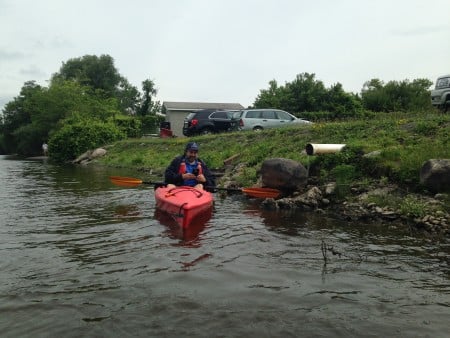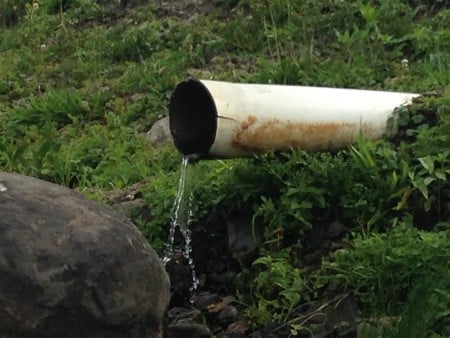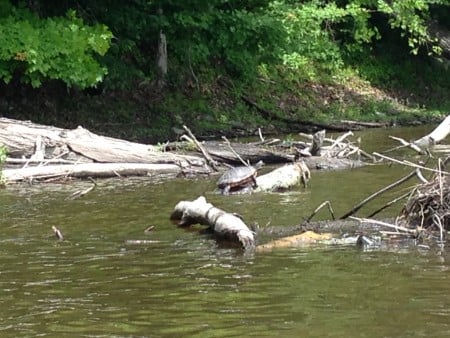Wallkill River ‘Boat Brigade’ Identifies Pollution Concerns
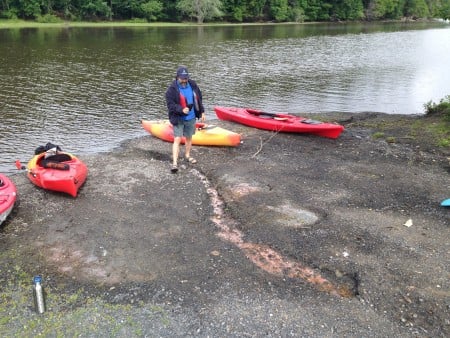
Arthur Cemelli documents seepage at the Popp Memorial Park boat launch on the Wallkill River. (Photo by Dan Shapley / RIverkeeper)
View more images on our Flickr site
Before the Wallkill River “Boat Brigade” had entered the water, its members had made the observations that will be its first report. What is that orange ooze, with rainbow sheen? It was seeping out of the ground in several rivulets at the boat launch at the Town of Shawangunk’s Popp Memorial Park, in the hamlet of Wallkill.
The participants June 6 included Brenda Bowers and Arthur Cemelli, organizers of the brigade who live in Shawangunk; Patricia Henighan, a member of the Town of Montgomery Conservation Advisory Council and a partner in Riverkeeper’s ongoing water quality sampling effort on the Wallkill; and me. We took detailed notes and photos as part of an inaugural survey of the Wallkill, the first of a planned monthly series of Boat Brigades in conjunction with a new citizen watershed group to get to know the Wallkill River, identify potential problems and solve them. The solving — if the seep proves to be more than just ugly — will come from reporting evidence of problems to the town, the Department of Environmental Conservation or others with jurisdiction and a responsibility to stop pollution.
The Boat Brigade idea came from Brenda Bowers. Riverkeeper is supporting the effort by sharing knowledge and techniques from years of our own Hudson River patrols, and from responding to watchdog complaints from citizens.

Arthur Cemelli documents seepage at the Popp Memorial Park boat launch on the Wallkill River. (Photo by Dan Shapley / RIverkeeper)
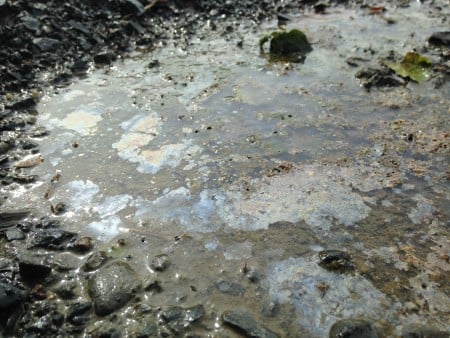
An oily sheen was visible on parts of the orange-colored seepage. (Photo by Dan Shapley / Riverkeeper)
On the water, the brigade identified two pipes with steady streams of water flowing, even though it had not rained in days. Are these stormwater pipes? The locations will be matched against the Hudson River Watershed Alliance’s online maps of stormwater system drains and outfalls, to see if they match. Those that match up, based on latitude and longitude coordinates, will be reported to the Town of Shawangunk’s Stormwater Public Contact, the person required under the state’s MS4 regulations to eliminate illicit discharges to the stormwater system. Broadly, any discharge through storm drains that isn’t caused by stormwater (rain running off streets, or streetwater) is illicit, though there are a number of exemptions (see pages 6 and 7 in the general permit that covers communities like Shawangunk). Whether these discharges run afoul of regulations will have to be determined.
If the pipes aren’t part of the stormwater system, then we’ll ask the Department of Environmental Conservation to investigate. The Clean Water Act makes it unlawful to discharge any pollutant from a point source, such as a pipe, without a permit. There are no permits for discharges at these points. Whether or not there are pollutants in the discharge will have to be determined.
Other than identifying potential problems like these, the main purpose of the Boat Brigade was to introduce more people to this stretch of the water. Those who know it will learn how to best protect it, by recognizing changes and feeling a gut-level need to protect it.
There’s plenty to like. The shallow riffles near the Orange-Ulster county line were humming with life, where our community scientist partners have observed some of the better water quality on the river. (Note that our samples are meant to assess when and where water meets guidelines for safe recreation, and are not meant to measure ecological health.) Dozens of swallows zipped and weaved through the air, snatching insects from the sky. The bushes buzzed with the whistles of red-winged blackbirds.
While wildlife along the stretch of the river’s edge that borders Route 208 was relatively scarce, the many trees and branches in the water on the side of the river that borders forest and fields on the bank opposite bank were filled with painted turtles. A huge snapping turtle skimmed the surface from its side of the water, before disappearing into the depths. A muskrat scurried for cover.
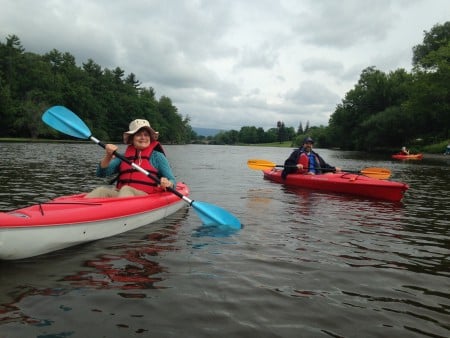
Patricia Henighan, Arthur Cemelli and Brenda Bowers paddle the Wallkill River. (Photo by Dan Shapley)
It’s a gorgeous river. It deserves a good set of watchdogs.
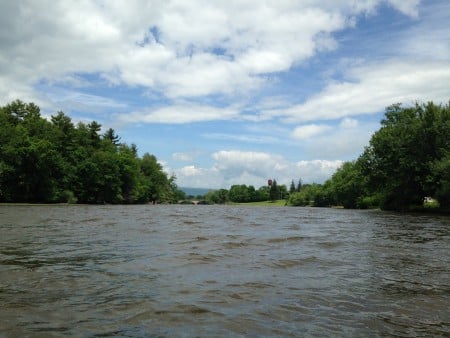
The Wallkill River, looking downstream from Popp Memorial Park in the hamlet of Wallkill. (Photo by Dan Shapley)
Join these upcoming Boat Brigades to do enjoy, observe and help the Wallkill:

